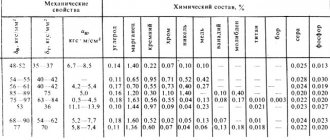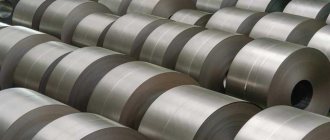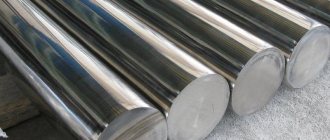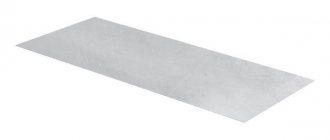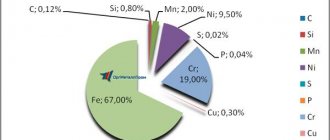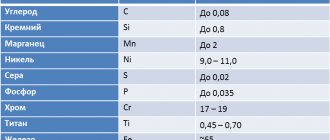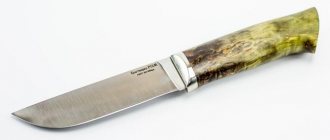Drill steel grades - which ones are better?
Nowadays, buying a high-quality metal drill is a real problem; most drills are Chinese, their quality leaves much to be desired. The quality of a drill depends, first of all, on the grade of steel from which the drill is made.
Most modern metal drills are made from R6M5 steel, although the difference between modern drills and drills from the USSR (with a quality mark) is simply huge, Chinese drills instantly roll up and it is impossible to drill even an ordinary corner made of 3mm iron with them. One drill is enough for several holes. However, there are also high-quality drills that last a long time.
Let's look at the steel grades, because the quality and durability of the drill depends on this.
P18 is now a legendary steel. Containing 18 percent tungsten, this steel supports metal processing even at high speeds. Drills made of P18 steel do not overheat, endure for a long time and drill well. True, finding the real ones is a whole problem. In Soviet times, r18 steel was used very widely for the manufacture of metal-cutting tools, but after the 70s, tungsten reserves were depleted and it was replaced by steel with a lower tungsten content - r6m5.
R6M5 - 6 percent tungsten, 5 percent molybdenum. Standard steel for metal-cutting tools. If the drill for metal is a Soviet one made from R6M5, then it is perfect for everyday use at home; such drills last for a long time, although they cannot drill through more hardened iron. The following drills with the addition of cobalt are suitable for this.
R6M5K5 is the same as R6M5, only 5 percent cobalt is added, which makes these drills even stronger and more durable. Cobalt drills are suitable for drilling where high temperatures are generated during drilling. Photo:
Excellent for drilling stainless steel and other hardened steels. In general, if ordinary drills do not take iron, then buy one with cobalt, you will feel the difference.
HSS is a foreign analogue of high-speed steel, translated as High Speed Steel, that is, steel for working at high speeds. HSS drills are similar in composition to the standard P6M5 high-speed cutter.
By the way, hss also comes with the addition of cobalt; drills are marked HSS-Co. Drills with this marking will be identical to our R6M5K5. Drills with cobalt - for drilling stainless steel and other durable steels.
It is also worth mentioning specialized drills for porcelain tiles, they are soldered and also come with crowns, if you are looking for information, follow the link, I prepared an article at the request of workers.
In general, if you decide to buy high-quality drills for your home, then I would recommend first asking around for drills from the USSR era; if they have a quality mark on them, then this is generally better than that. Soviet ones are inexpensive, you can even look at flea markets, you can probably find something there too.
Sovdepov drills are an excellent tool. If you take imported ones, then they cost a lot, for example, 6 mm HSS-Co drills cost around 70-80 rubles, while a similar Soviet one can be bought for 20-30 rubles.
Source
Analogs
Foreign analogues of the alloy:
| USA | Germany | Japan | France | England | Italy | Spain | China | North Korea |
| T11302 M2 | 1.3343 HS6-5-2 S6-5-2 S6-5-2S SC6-5-2 X82WMoCrV6-5-4 | SKH51 | HS6-5-2 HS6-5-2HC X85WMoCrV6-5-4 Z85WDCV | 3343 BM2 | HS6-5-2 X82WMoV6-5 | 6-5-2 EM2 HS6-5-2 | W6Mo5Cr4V2 | SKH51 |
Previous
KnivesPhrases for engraving on knives
Next
KnivesSteel M390: characteristics and properties
R18 or R6M5 which is better
High speed steels
- alloy steels, intended mainly for the manufacture of metal-cutting tools operating at high cutting speeds.
High-speed steel must have high fracture resistance, hardness (in cold and hot states) and red resistance.
Carbon tool steels also have high fracture resistance and cold hardness. However, tools made from them are not able to provide high-speed cutting conditions. Alloying high-speed steels with tungsten, molybdenum, vanadium and cobalt ensures hot hardness and red-hardness of the steel.
Chemical composition
The concentration of certain elements determines the basic properties of steel, as well as its scope. The composition of P18 steel includes the following elements:
- Most of the composition is made up of iron, the concentration of which is about 73%.
- A small amount of chromium is added. By increasing its concentration to 4%, the created tool becomes more resistant to corrosion.
- Special elements that increase the performance characteristics of the material are vanadium and molybdenum (no more than 1.4%).
- Carbon is the main chemical element of almost all metals, in this case the concentration is 0.8%. A relatively small amount of carbon in the composition determines high weldability. Increased hardness is achieved through the inclusion of other chemical elements.
Chemical composition of P18 steel and other high-speed steels
Other chemical elements account for no more than 1%. Particular attention is paid to harmful impurities, an increase in the concentration of which leads to a decrease in basic performance characteristics.
Creation stories [edit | edit code]
For turning parts made of wood, non-ferrous metals, and mild steel, cutters made of ordinary hard steel were quite suitable, but when processing steel parts, the cutter quickly heated up, soon wore out, and the part could not be turned at a speed of more than 5 m/min [1].
This barrier was overcome after R. Muschette produced steel containing 1.85% carbon, 9% tungsten and 2.5% manganese in 1858. Ten years later, Muschette made a new steel, called self-heating steel. It contained 2.15% carbon, 0.38% manganese, 5.44% tungsten and 0.4% chromium. Three years later, production of muschette steel began at Samuel Osburn's Sheffield plant. It did not lose its cutting ability when heated to 300 °C and made it possible to increase the metal cutting speed by one and a half times - 7.5 m/min.
Forty years later, high-speed steel from American engineers Taylor and Watt appeared on the market. Cutters made of this steel allowed cutting speeds of up to 18 m/min. This steel became the prototype of modern high-speed steel R18.
Another 5-6 years later, ultra-high-speed steel appeared, allowing cutting speeds of up to 35 m/min. Thus, thanks to tungsten, a sevenfold increase in cutting speed was achieved over 50 years and, consequently, the productivity of metal-cutting machines increased by the same amount.
Further successful use of tungsten found application in the creation of hard alloys, which consist of tungsten, chromium, and cobalt. Alloys for cutters such as stellite were created. The first stellite made it possible to increase the cutting speed to 45 m/min at a temperature of 700–750 °C. The alloy of this type, released by Krupp in 1927, had a Mohs hardness of 9.7-9.9 (the hardness of diamond is 10).
In the 1970s, due to a shortage of tungsten, high-speed steel grade R18 was almost universally replaced by steel grade R6M5 (the so-called “samokal”, self-hardening steel), which, in turn, was replaced by tungsten-free R0M5F1 and R0M2F3.
Peculiarities
Steel grades R6M5 and R18 are used not only in the manufacture of knives, but also in the production of taps, drills, and industrial cutting tools. They are distinguished by their ability to maintain hardness and sharpness when exposed to high temperatures and significant shock loads. The high content of carbon and tungsten in the composition gives steel these characteristics.
Heat treatment
To give knives made from P18 and P6M5 increased strength and wear resistance, the metal is subjected to appropriate heat treatment. It takes place in 2 stages:
- Hardening – heating to a temperature of 1200-1300C. To avoid the formation of cracks, it is carried out gradually. First, the metal is heated to a temperature of 400-500C, then to a temperature of 800-850C. At maximum heating, the workpiece is subjected to heat treatment for a limited time (10-15 seconds for each millimeter of thickness). During hardening, the carbide decomposes, the alloy is saturated with tungsten and carbon.
- Vacation is carried out at a temperature of 550-560C. It is carried out in 2-3 stages, each lasting at least an hour. At the same time, the strength characteristics of the metal increase.
Steel is heated in special salt baths, which consist of barium chloride (78%) and sodium chloride (22%). Magnesium fluoride is used to deoxidize the solution.
Production of cutting tools
After heat treatment of the steel, the production of cutting tools begins. For this purpose, the workpieces, which are previously checked for compliance with GOST requirements, are sent for grinding. Products made from P18 steel are easier to grind, but they also retain their sharpness for a shorter period of time. Knives made from R6M5 alloy can only be sharpened with professional tools and skills, but their sharpening quality is much better. In production, specialized machines are used for grinding workpieces made of steel R18 and R6M5.
Knife Grif steel P18, birch bark handle.
Use in cutting
Knives made of steel P18 and P6M5 are quick-cutting and universal in use. The metal performs well under heat and mechanical stress. It does not lose strength or deform. Manufacturers of knives made from these steel grades conducted experiments during which they successfully coped not only with slicing various food products (meat, bones, cartilage), but also with cutting wood and even metal plates several millimeters thick!
Characteristics of high-speed steels [edit | edit code]
Hot hardness [ edit | edit code]
At normal temperatures, the hardness of carbon steel is even slightly higher than the hardness of high-speed steel. However, during operation of the cutting tool, intense heat is generated. In this case, up to 80% of the released heat is spent on heating the instrument. Due to an increase in the temperature of the cutting edge, the tool material begins to temper and its hardness decreases.
After heating to 200 °C, the hardness of carbon steel begins to rapidly decrease. For this steel, a cutting mode in which the tool would heat up above 200 °C is unacceptable. High-speed steel retains its high hardness when heated to 500–600 °C. High speed steel tools are more productive than carbon steel tools.
What is shx15?
The letter Ш at the beginning of the steel grade means that the steel is bearing, 15 indicates the chromium content in the steel is approximately 1.5%. Bearing steel ШХ15
used for the manufacture of parts that require high hardness, wear resistance and contact strength.
Interesting materials:
How to choose quality bed linen? How to choose a ceiling clothes dryer? How to choose a ceiling curtain rod? How to choose the right pot for an orchid? How to choose the right collar? How to choose a juice press? How to choose a set-top box for an old TV? How to choose a DVB-T2 set-top box? How to choose a projector for home 2022? How to choose a projector for your home theater?
Marking of high-speed steels [edit | edit code]
In Soviet and Russian steel grade books, high-speed steel grades usually have a special designation system and begin with the letter “P” (rapid - fast). This is due to the fact that these steels were invented in England, where such steel was called “rapid steel”. The number after the letter “P” indicates the average tungsten content in it (as a percentage of the total mass, the letter B is omitted). Then the content of molybdenum, vanadium and cobalt is indicated after the letters M, F and K. Foreign-made high-speed steel tools are usually marked with the abbreviation HSS (High Speed Steel), as well as HSSE (cobalt steel).
P18 high-speed tool steel
Substitute
Steel P12
Foreign analogues
| Germany (DIN) | Euronorms (EN) |
| HS 18-0-1 | 1.3355 |
Decoding
The letter "P" means that the steel is high-speed. The number 18 after the letter “P” indicates the average tungsten content in percent, i.e. for P18 steel the tungsten content is 18%.
Type of delivery
- Long products, including shaped steel: GOST 19265-73, GOST 2590-88, GOST 2591-88.
- Calibrated rod GOST 19265-73, GOST 7417-75.
- Polished rod and silver steel GOST 19265-73, GOST 14955-77.
- Thick sheet TU 14-1-1408-75.
- Thin sheet TU 14-1-1706-76, TU 14-1-1408-75.
- Strip GOST 19265-73, GOST 4405-75.
- Wire TU 14-1-1096-74.
- Forgings and forged blanks GOST 19265-73, GOST 1133-71.
Characteristics and description
High-speed steel P18 appeared at the turn of the 19th-20th centuries (inventors F. Taylor and A. White). Steel P18 is characterized by the following properties:
- Viscosity is good
- Wear resistance is good,
- Sandability - increased
- Red resistance 59HRCe when tempered for 4 hours, °C - 620
In addition, P18 steel is characterized by a reduced tendency to overheat during hardening.
In annealed form, the structure of P18 steel consists of an α-solid solution and carbides. All alloying elements (Cr, W, Mo, V). The main carbides in high-speed steel are M6S, MC, M23S6 and M3S carbides of approximately the same composition for all steels (see table below).
Depending on the composition of the steel, first of all, the (W + Mo)/V ratio also changes and the M6C/MS ratio. There is almost no MC carbide in P18 steel. In addition to these carbides, in some cases carbides M23C6, M3C may be present in small quantities; M2C carbide is released during tempering.
Due to the shortage of tungsten in the 70s of the last century, R18 steel began to be replaced with R6M5 steel.
Purpose and application
High-speed steel R18 is used in the manufacture of parts and all types of cutting tools for processing structural steels with a strength of up to 1000 MPa, which are required to maintain cutting properties when heated during operation up to 600 °C, for example:
- incisors,
- drill,
- cutters,
- thread cutters,
- cutters,
- sweeps,
- Venkers,
- taps,
- broaches
Temperature of critical points, °C
| Ac1 | Ac3 | Ar3, | Ar1 |
| 820 | 860 | 770 | 725 |
Chemical composition (GOST 19265-73)
| steel grade | Mass fraction of element, % | |||||||||||||
| carbon | manganese | silicon | chromium | tungsten | vanadium | cobalt | molybdenum | nickel | copper | sulfur | phosphorus | nitrogen | niobium | |
| no more | ||||||||||||||
| P18 | 0,73-0,83 | 0,20-0,50 | 0,20-0,50 | 3,80-4,40 | 17,00-18,50 | 1,00-1,40 | No more than 0.50 | No more than 1.00 | 0,6 | 0,25 | 0,030 | 0,030 | — | — |
Heat treatment (hardening)
To give high-speed steel the best cutting properties, it is necessary to transfer the largest amount of alloying elements from carbides into a metal base, into a solid solution. This is done by heating for hardening.
The pearlite-austenitic transformation when heating P18 steel occurs at 780-820°C. Since pearlite contains 0.1-0.2% carbon, quenching after such heating leads to the production of low-carbon martensite with low hardness: HRC 45-50.
The following hardening mode for P18 steel is recommended:
- heating rate vср = 50-100 °C/s (induction heating);
- heating temperature 1280-1320 °C
- cooling in oil or air
Temperature conditions for heat treatment of tools made of P18 steel
| Hardening | ||
| temperature, °C | Hardness HRC | amount of austenite,% |
| 1270-1290 | 62-64 | 25 |
| Vacation | ||
| temperature, °C | number of holidays | Hardness HRC |
| 560 | 3 | 63-65 |
Steel hardness R18 (GOST 19265-73)
The hardness of P18 steel in the annealed state, the hardness of the samples after quenching and tempering, and the quenching and tempering temperatures must correspond to the values indicated in the table below.
| steel grade | Hardness | Temperature, °C | |||
| after annealing | after hardening and tempering HRC3 (HRC), not less | hardening | vacations | ||
| NV, no more | imprint diameter, mm, not less | ||||
| P18 | 255 | 3,8 | 63(62) | 1270 | 560 |
Mechanical properties of steel as delivered (after annealing) at 20 °C (GSSSD 9-79)
| σ0.05, MPa | σ0.2, MPa | σв, MPa | δ5, % | ψ % | σcom0.2, MPa | σcom, MPa | ε, % | τk, MPa | v, % | KCU, J/cm2 |
| 210(5) | 510(20) | 840(30) | 8(1) | 10(1) | 520(13) | 2600(80) | 50(1,5) | 560(17) | 50(0,7) | 19(1) |
Mechanical properties of steel in a heat-treated state (GSSSD 9-79)
| σ0.05, MPa | σв, MPa | σcom0.2, MPa | σcom, MPa | tk, MPa | σben, MPa | KSU, J/cm2 |
| 2480(70) | 2150(110) | 3060(90) | 3820(120) | 1880(100) | 3000(200) | 30(3) |
Mechanical properties of steel as delivered (after annealing) at elevated temperatures (GSSSD 9-79)
| tsp, °С | σ0.2, MPa | σв, MPa | δ5, % | ψ % | σcom, MPa | tk, MPa | KCU, J/cm2 | Hardness HB |
| 200 | 450(50) | 830(80) | 13(2) | 22(4) | 1050(50) | 520(30) | — | 227(6) |
| 400 | 420(40) | 700(70) | 15(2) | 22(4) | 850(50) | 450(30) | — | 210(6) |
| 600 | 300(40) | 480(50) | 31(3) | 55(6) | 620(20) | 300(20) | — | 140(6) |
| 800 | 110(20) | 200(20) | 60(5) | 70(6) | 100(20) | 100(20) | — | 30(4) |
| 1000 | 90(20) | 100(20) | 42(4) | 55(6) | 50(10) | 50(10) | 100(10) | 24(4) |
| 1100 | — | — | — | — | — | — | 130(15) | — |
| 1200 | 30(10) | 30(10) | 12(3) | 25(5) | 40(10) | 40(10) | 45(5) | 4(1) |
Mechanical properties of steel in a heat-treated state at elevated temperatures (GSSSD 9-79)
| tsp °C | σben, MPa | Hardness | tsp °C | σben, MPa | Hardness | ||
| H.V. | HRСе | H.V. | HRСе | ||||
| 200 | 3570(180) | 815(10) | 64 | 550 | 3060(150) | 661(10) | 58 |
| 400 | 3730(180) | 755(10) | 62 | 600 | 2430(120) | 615(10) | 56 |
| 500 | 3290(160) | 712(10) | 60 | 650 | 2180(110) | 504(10) | 51 |
Mechanical properties depending on tempering temperature
| ttp, °С | σв, MPa | KCU, J/cm2 | Hardness HRCе |
| 400 | 1370 | 23 | 61 |
| 500 | 1470 | 19 | 63 |
| 550 | 2350 | 17 | 66 |
| 600 | 2210 | — | 65 |
NOTE. Hardening at 1280 °C in oil; vacation three times for 1 hour.
Technological properties
Forging temperature, °C: beginning 1200, end 900. Cooling in wells at 750-800 °C.
Weldability is good for electric butt welding with steels 45 and 40X.
Machinability - Kv tv.spl = 0.6 and Kv b.st = 0.3 by cutting at HB 212-228.
Density ρп kg/cm3 at test temperature, °С
| Steel | 20°C |
| P18 | 8800 |
Thermal conductivity coefficient λ W/(m*K)
| Steel grade | λ W/(m*K), at test temperature, °C | |||||||||
| 20 | 100 | 200 | 300 | 400 | 500 | 600 | 700 | 800 | 900 | |
| P18 | — | 26 | 27 | 28 | 29 | 28 | 27 | 27 | — | — |
Electrical resistivity ρ nom*m
| steel grade | ρ nom*m, at test temperature, °C | |||||||||
| 20 | 100 | 200 | 300 | 400 | 500 | 600 | 700 | 800 | 900 | |
| P18 | 419 | 472 | 544 | 627 | 718 | 815 | 922 | 1037 | 1152 | 1173 |
Young's modulus (normal elasticity) E, GPa
| Steel grade | At test temperature, °C | ||||||
| 20 | 100 | 200 | 300 | 400 | 500 | 600 | |
| P18 | 228 | 223 | 219 | 210 | 201 | 192 | 181 |
Modulus of elasticity in torsional shear G, GPa
| steel grade | At test temperature, °C |
| 20°C | |
| P18 | 83 |
Find out more
Steel 12Х21Н5Т (EI811) corrosion-resistant austenite…
Structural alloy steel 35ХМ…
Structural alloy steel 40ХС…
Steel 25 structural carbon steel…
Application [ edit | edit code ]
In recent decades, the use of high-speed steel has been declining due to the widespread use of hard alloys. High-speed steel is used mainly for making end tools (taps, drills, cutters of small diameters). In turning, cutters with replaceable and brazed carbide inserts have almost completely replaced cutters made of high-speed steel.
There are the following recommendations for the use of domestic grades of high-speed steels.
- P9 steel is recommended for the manufacture of tools of simple shapes that do not require a large amount of grinding, for processing common structural materials. (cutters, cutters, countersinks).
- For shaped and complex tools (for cutting threads and teeth), for which the main requirement is high wear resistance, it is recommended to use P18 (tungsten) steel.
- Cobalt high-speed steels (R9K5, R9K10) are used for processing parts made of difficult-to-machine corrosion-resistant and heat-resistant steels and alloys, under conditions of intermittent cutting, vibration, and insufficient cooling.
- Vanadium high-speed steels (R9F5, R14F4) are recommended for the manufacture of tools for finishing (broaches, reamers, shaver). They can be used for processing difficult-to-cut materials when cutting chips with a small cross-section.
- Tungsten-molybdenum steels (R9M4, R6M3) are used for tools operating in roughing conditions, as well as for the manufacture of broaches, cutters, shaver, and milling cutters.
The density of the metal is so high that special tools and mechanisms must be used to process it. In order to make a hole in this material, drills and drilling machines are used, in which drills are the main cutting element.
Which metal drills are better? It is not easy to determine, because there are no universal products that would be suitable for processing all types of metal products. An experienced craftsman will be able to “by eye” determine the type of metal and quickly select the appropriate cutting tool for processing.
A beginner in this business needs to start with the basics. First, study the classification of drills and their scope of application, because the best models are products that are ideal for processing a specific type of metal.
What kind of drills there are, how to choose a suitable product for the job based on markings and appearance, find out in the article.
Types of drills for metal
To choose the best models, you need to understand the types of drills.
Spiral
Classic, cylindrical drills that are most often used for drilling metals. Typically, spiral products are made of HSS steel.
The material is a high-quality cutting type of steel, so the gimlets made from it are highly durable and durable.
Conical (stepped)
The cutting surface has the shape of a cone, which is why this type of drill got its name. Conical drills are used to make holes in thin metal, as well as to correct defects from other cutting tools.
What are the best step drills to choose? Depends on the type of metal being processed. If the density of the workpiece is too high, then it is better to purchase more expensive, golden-colored products.
In everyday life, this type of drill is rarely used. If you need to frequently drill thin metal sheets or process soft materials, then despite the relatively high cost, it should be purchased for your home workshop.
Core cutters (annular cutters)
The cutting tool is a cylinder with a cutting edge, which is used to cut metal.
The energy consumption for making a hole in this way is several times lower, due to the small contact area of the tool with the surface being processed.
The advantage of using this type of drill over others is the production of large diameter holes. In this case, it is possible to obtain better quality edges than when working with spiral models.
Feathers
A special type of flat gimlet with replaceable working edges is used for drilling metal. Such products allow you to make high-quality, perfectly straight holes.
The absence of distortion during the drilling process and the ability to make a large-diameter hole in various metal structures allows many craftsmen to abandon the use of spiral products.
The low cost of feather drills allows in many cases of metal processing to call them the best for drilling holes.
These are the main types of drills used for making holes in metal structures.
Classification of drills by material of manufacture
Which metal drills are the best for drilling particularly strong alloys is quite simple to answer:
- To process such material, you should choose products that have a plate of increased hardness on the cutting edge. Such gimlets are the best for processing hard alloys.
- The price of such products is low due to the fact that the main body of the cutting tool is made of ordinary tool steel.
Drills made of metal alloyed with cobalt have good characteristics.
They can withstand increased mechanical loads and excessive heating of the working surface during operation. The cost of the products is high, but if it is necessary to make holes in a hard alloy, then cobalt analogues are the best for performing such work.
Titanium drills are not inferior in strength to cobalt drills, and when drilling alloy steels and non-ferrous alloys they show even better results.
When used correctly, titanium models retain their factory sharpness for a long time, which will allow you to perform a significantly larger volume of work.
Inexpensive metal drills are made from ordinary high-speed steel P9 and P18. The cutting tool copes with its function perfectly, but the working surface quickly becomes dull, especially when a certain temperature threshold is exceeded.
Features of steel sharpening
Any product is subject to wear, and if it is a blade, to loss of sharpness. R6M5 steel, due to its special manufacturing method and chemical composition, is difficult to sharpen.
Electrocorundum grinding wheels are not able to cope with such a problem. The blade being sharpened will remain uneven, and the cutting qualities will be far from working. Therefore, to restore a product to its factory sharpening, it must be processed on CBN wheels, which are not available at every specialized sharpening machine.
An example of proper knife sharpening.
Marking of cutting products
Marking drills for metal is necessary to determine the type of steel from which the cutting tool is made. The product also indicates its diameter, accuracy class and manufacturer (country). Only spiral gimlets with a diameter of less than 2 mm are not marked.
In other cases, drill markings may have the following meanings:
- P9 - made of high-speed steel with a tungsten percentage of 9%.
- P9K15 - indicates the presence of cobalt in the high-speed steel in an amount of 15%.
- Р6М5К5 - indicates the presence of a complex composition of cutting steel containing tungsten, cobalt and molybdenum.
Imported products have the HSS designation, which can be used to determine the composition of the material from which the drill was made. The HSS drill, which will be explained below, is used with an additional letter, which determines the presence of alloying metal.
- HSS-E - contains cobalt. Used in processing metals of high viscosity.
- HSS-Tin - has titanium coating, which significantly increases the hardness of the working surface, and the temperature resistance of the material increases to +600 degrees.
- HSS-E VAP is a cutting tool used for processing stainless materials.
- HSS-4241 - designed for drilling aluminum.
- HSS-R - have maximum strength.
Main characteristics
The basic parameters of steel of this grade are: high toughness, excellent wear resistance, and a good level of grindability. This grade is used in the production of many types of blades and cutting equipment for working with structural strength steels.
Knife with a blade made of steel R6M5.
A tungsten-molybdenum alloy is the second name of this brand, which can retain its characteristic qualities even under extreme temperature changes. Moreover, its bending strength reaches 4700 MPa. Its combination with impact strength gives it a noticeable superiority over many of its peers.
Visual identification of drill type
By the appearance of the cutting gimlet, you can determine the type of material from which the products are made and thereby find out the mechanical strength of the sample. By color you can determine the composition and quality of workmanship.
Grey
Gray drills are made of metal that has not been subjected to any additional processing.
The quality of the tool, in this case, leaves much to be desired, but for one-time use such products are quite suitable.
Black
This color indicates that the tool was treated with superheated steam. During processing, the product acquires greater strength.
It perfectly tolerates numerous cycles of heating and cooling of the metal, and also maintains the sharpening of the working surface for a long time.
The price of black metal drills is not much higher than gray products, so if you have a choice, you should give preference to tools of this type when purchasing.
Dark golden
This color indicates that the cutting tool has been tempered. This type of processing significantly increases the mechanical strength of the product as a result of reducing internal stresses.
With a tempered drill, you can successfully process high-strength metals, so if you are drilling too hard alloys, it is recommended to purchase a similar model.
Bright golden
The bright golden color indicates that metal made with the addition of titanium was used in production.
Despite the high cost of such models, it is much more practical to purchase a high-quality drill than to use cheap cutting tools, which will need to be used in large quantities for complex work.
Thus, it is easy to determine the quality of products by appearance and decide which metal drills are best to buy.
Classification by size
To choose the best drill and not overpay, it is enough to know what length sizes these products are usually divided into. If drilling metal does not require making deep holes, then purchasing models that are too long will lead to cost overruns.
It is customary to classify drills by length as follows:
- Short, 20-131 mm long. Tool diameters are in the range of 0.3-20 mm.
- Elongated, length is 19-205 mm, and diameter is 0.3-20 mm.
- Long series with a diameter of 1-20 mm and a length of 56-254 mm.
When performing drilling work of various depths, you should select the tool that is most suitable for the specific task.
The best manufacturers
To purchase drills and be sure that the declared characteristics are completely true, you need to choose the right manufacturer.
Companies that value their reputation do not sell products of inadequate quality. Therefore, when choosing metal drills, you should give preference to manufacturers who have been on the market for a long time.
Among the newcomers, there may also be worthy producers. But in order to find out that a good quality product is on sale, you need to make a purchase, which often represents a “lottery”.
1. Bosch - products of the German company have long proven themselves only on the positive side. Despite the rather high price of the products, when purchasing Bosch drills, you can rest assured of excellent quality. It is convenient and profitable to purchase tools from this company as a set.
Whatever set of drills you take, each one will contain only the highest quality products that will last for many years, provided they are properly stored and used.
2. “Zubr” is a domestic manufacturer whose products are maximally optimized in terms of price-quality ratio. You can purchase the products of this company either in a single copy or in the form of a set. The latter option will significantly save money, despite the significant cost of the kit.
3. Soviet-made drills - this category of cutting tools can be classified as an “endangered species.” With due diligence, you can purchase a rarity that has unsurpassed technical characteristics.
Conclusion
Which metal drills are best to buy depends on many circumstances:
- If you need to drill several holes in very thin and soft metal, then just buy a cheap drill that will do the job.
- For professional use, it is not at all profitable to purchase cheap drills. Low-quality products can lead to defects and significant time costs for frequent replacement of low-quality cutting tools.
Phone in Moscow, [email protected]
